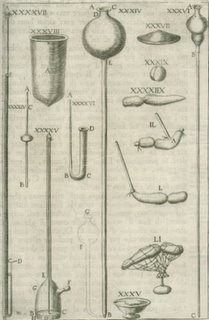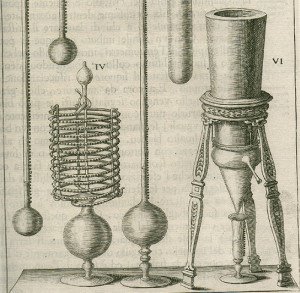

I've mentioned the Accademia dei Lincei (Lynx Academy) previously. A dispute among the members over the Copernican world view caused it to disband in ~1630. Soon after, Galileo was condemned by the church. The seat of learning for science shifted away from Rome to Naples and Florence as a consequence.
In 1657 the Accademia del Cimento was founded in Florence. Although it was relatively short lived, its secretary, Lorenzo Magalotti, compiled a groundbreaking volume of 10 years of the Academy's experiments in 1666. Saggi di Naturali Esperienze ("Essays on Natural Experiments") which included the work of Torricelli among others also has 75 full page engravings.
Academy members "worked together at experimentation of all sorts and eschewed speculative thinking. Together they worked out new research methods, invented new instruments, and devised better standards of measurement." Essays was regarded as the founding of modern physics and had widespread influence. It was translated and republished in a number of languages over a couple of centuries.
The Instituto E Museo Di Storia Della Scienza have the whole Saggi di Naturali Esperienze manuscript online (in fact they also have a number of subsequent editions available - although some of the engravings were remade and a few extra illustrations included, there were none that I found of any great aesthetic value - they are mildly interesting for comparing engraving qualities)
skip to main |
skip to sidebar


analytics
Books~~Illustrations~~Science~~History~~Visual Materia Obscura~~Eclectic Bookart.

Contact | Who?
Recommended Blogs
Blog Archives
Resource Sites
- digital nz
- library of congress
- british library
- library france
- library holland
- library spain
- library portugal
- european library
- library australia
- collections canada
- digital poland
- nypl digital
- botanicus digital
- v&a collections
- britmuseum prints
- smithsonian search
- smithsonian galaxy
- f.a.m.s.i.
- casglu'r tlysau
- rumsey collection
- manuscript catalogue
- digital scriptorium
- cesg manuscripts
- swiss manuscripts
- pecia mss blog
- digital book index
- rare book room
- online exhibitions
- primary sources
- worldcat search
- library directory
- digital librarian
- intute resources
- warburg institute
- lexilogos links
- digiwiki links
- museum blogs
- book arts web
- culture archive
- conservation articles
- art-history timeline
- visual arts
- arts journal
- artcyclopedia
- ukiyo-e
- calligraphy megapage
- penmanship
- woodblock
- coconino
- alchemy website
- health hist. img-banks
- health history links
- history network
- new advent


















1 comment :
If you want to vave a good guide for academy in Florence take into consideation o walk down its medieval alleys and historical piazzas seeing its antique workshops, the homes of the artists, the basilicas and all the most important churches.
Post a Comment
Comments are all moderated so don't waste your time spamming: they will never show up.
If you include ANY links that aren't pertinent to the blog post or discussion they will be deleted and a rash will break out in your underwear.
Also: please play the ball and not the person.
Note: only a member of this blog may post a comment.